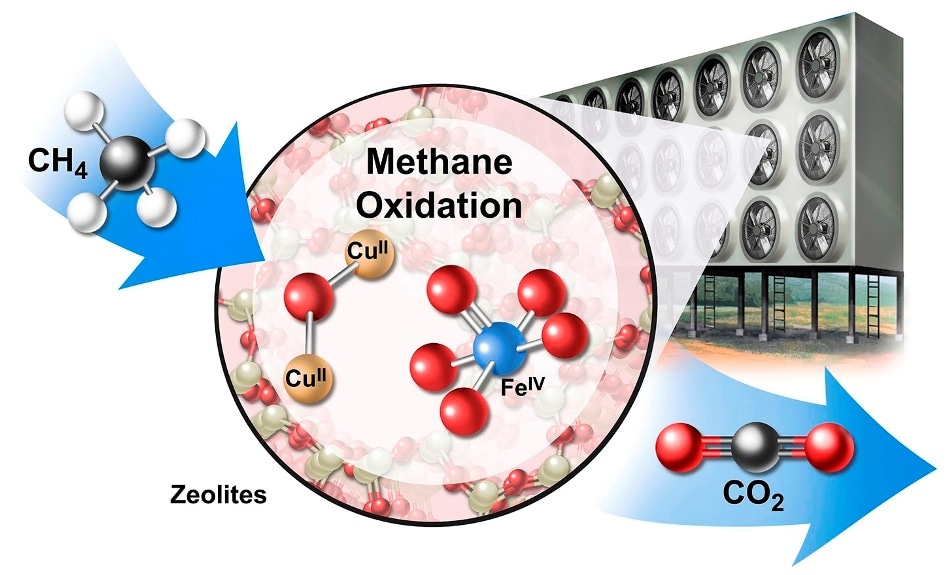May 21 2019
A comparatively easy process could help reverse the trend of climate change while also leading to a healthy profit.
 A conceptual drawing of an industrial array for converting methane (CH4) to carbon dioxide (CO2) using catalytic materials called zeolites (CUII and FEIV). (Image credit: Jackson, et al. 2019 Nature Sustainability/Artist: Stan Coffman)
A conceptual drawing of an industrial array for converting methane (CH4) to carbon dioxide (CO2) using catalytic materials called zeolites (CUII and FEIV). (Image credit: Jackson, et al. 2019 Nature Sustainability/Artist: Stan Coffman)
That is one of the promising visions described in a new Stanford-led paper that underlines an apparently counterintuitive solution—transforming one greenhouse gas into another.
The research, reported in Nature Sustainability on May 20th, 2019, explains a prospective process for turning the very powerful greenhouse gas methane into carbon dioxide, which is a much less potent driver of global warming. The concept of deliberately liberating carbon dioxide into the atmosphere may seem shocking, but the authors claim that swapping methane for carbon dioxide is an important net benefit for the climate.
If perfected, this technology could return the atmosphere to pre-industrial concentrations of methane and other gases.
Rob Jackson, Study Lead Author, Michelle and Kevin Douglas Provostial Professor in Earth System Science, Stanford’s School of Earth, Energy & Environmental Sciences
The fundamental concept is that certain sources of methane emissions, such as those from rice cultivation or cattle, may be very hard or expensive to eliminate.
An alternative is to offset these emissions via methane removal, so there is no net effect on warming the atmosphere.
Chris Field, Study Co-Author, Perry L. McCarty Director, Stanford Woods Institute for the Environment
A Problem and a Possible Solution
In 2018, methane—around 60% of which is produced by humans—reached atmospheric concentrations two and a half times beyond the pre-industrial levels. While the amount of carbon dioxide in the atmosphere is much greater, methane is 84 times more powerful when it comes to warming the climate system for the first two decades after its discharge.
Most instances where average global temperatures are stabilized at 2 ○C above pre-industrial levels are dependent on strategies for minimizing the overall amount of carbon dioxide entering the atmosphere as well as for eliminating what is already in the atmosphere through ways like underground sequestration or tree planting. However, eliminating other greenhouse gases, specifically methane, could offer a complementary strategy, report the study’s authors, who emphasize the outsized effect of gas on the climate.
Majority of the cases for eliminating carbon dioxide usually take on hundreds of billions of tons eliminated over decades and do not restore the atmosphere to pre-industrial levels. On the contrary, methane concentrations could be restored to pre-industrial levels by eliminating around 3.2 billion tons of the gas from the atmosphere and turning it into an amount of carbon dioxide comparable with a few months of global industrial emissions, according to the scientists. If successful, the method would remove nearly one-sixth of all causes of global warming until now.
It is difficult to capture methane from the air as its concentration is very low. However, the authors indicate that zeolite, a crystalline material that is mainly comprised of silicon, aluminum, and oxygen, could act typically like a sponge to absorb methane.
The porous molecular structure, relatively large surface area and ability to host copper and iron in zeolites make them promising catalysts for capturing methane and other gases.
Ed Solomon, Monroe E. Spaght Professor of Chemistry, School of Humanities and Sciences, Stanford University
The entire process might take the structure of a huge machine with electric fans forcing air through tumbling chambers or reactors filled with powdered or pelletized zeolites and other catalysts. The entrapped methane could subsequently be heated to produce and discharge carbon dioxide, propose the authors.
A Profitable Future
The process of transforming methane into carbon dioxide could be gainful with a price on carbon emissions or a suitable policy. In case the market prices for carbon offsets increase to $500 or more per ton this century, as estimated by most pertinent assessment models, each ton of methane removed from the atmosphere could be worth more than $12,000.
A zeolite array, which is about the size of a football field, could offer millions of dollars a year in income while eliminating detrimental methane from the atmosphere. Theoretically, the scientists claim that the method of turning a more damaging greenhouse gas to one that is less powerful could also apply to other greenhouse gases.
Although minimizing greenhouse gases in the atmosphere to pre-industrial levels may seem doubtful in the near future, the scientists claim that it could be possible with approaches such as these.